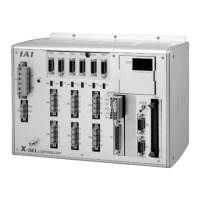297
INTELLIGENT ACTUATOR
Part 4 Commands
* When reverting the conditions to their defaults
[Example2] LET 290 3 Set the target axis pattern (axes 1 and 2) in integer variable 290.
LET 291 1000 Set a steady-state torque limit (maximum limit set for each axis) in integer
variable 291.
LET 292 20000 Clear the “steady-state torque limit over” detection time in integer variable
292. (Set “20000” to clear the setting.)
STOP *290 Clear a low-torque axis deviation counter.
ECMD 250 290 Read the values of three consecutive variables starting from variable 290.
Target axis pattern = Axes 1 and 2
Steady-state torque limit = Maximum limit set for each axis (The setting is
reverted to the maximum torque.)
“Steady-state torque limit over” detection time = 20,000 msec
MOVP 2 Move to position No. 2 at the steady-state torque.
(Note1) When a low torque is set, the load may drop (in the case of a vertical axis, etc.) or overshoot may
occur. If the torque is reduced during high-speed operation, overshoot may occur due to insufficient
torque.
(Note2) It is dangerous to change the torque to a lower setting during high-speed operation, because the
actuator may not decelerate normally due to insufficient torque and overshoot as a result.
(Note3) If positioning operation is performed at low torque, the axis may stop and remain stationary near the
target position due to insufficient torque. Before commencing axis movement, always set the “steady-
state (non-push motion) torque limit over” detection time to 1 msec or longer to detect a condition of
steady-state (non-push motion) torque limit over (timeout).
* If the “steady-state (non-push motion) torque limit over” detection time is set to “0” for the purpose of
setting a “torque limit for the supporting axis during engagement (applicable to a horizontal axis
only)” and the position data used in the return operation following the engagement operation (as a
result of a PUSH command, etc.) includes the coordinates of the supporting axis during
engagement (whose torque is limited), positioning operation will be performed during the return
operation following the engagement operation to move the actuator position to the coordinates of
the axis whose torque is limited, in which case the actuator may stop near the target value due to
insufficient torque. When setting position data for the return operation following the engagement
operation, be sure to set only the coordinates of the operating axis during engagement (axis used in
the PUSH command, etc.)
(Note4) If an extremely low torque is set, a servo-ON axis may move at a very slow speed due to an analog
offset error, etc.
(Note5) The torque increases during acceleration/deceleration even under a normal load condition.
Accordingly, determine each setting (steady-state torque limit, “steady-state torque limit over”
detection time) as deemed appropriate so that a steady-state torque limit over error will not be
detected.
(Note6) An “Error No. C6B, Deviation overflow error” or “Error No. CA5, Stop-deviation overflow error” may
generate before an “Error No. 420, Steady-state (non-push motion) torque limit over error” is detected.
This is normal and does not indicate a malfunction.
(Note7) When changing to a high torque setting from a low torque setting at which axis movement cannot be
assured, be sure to issue a STOP command to the low-torque axis to clear the deviation counter
before changing to the high torque setting (i.e., while the torque is still low). If the torque setting is
changed from low to high while deviation pulses are still stored, the axis may move at an uncontrolled
speed and create a dangerous situation.
(Note8) When returning to a normal condition (maximum torque), expressly specify “1000%” as the “steady-
state (non-push motion) torque limit (maximum limit)” and “20000 msec” as the “steady-state (non-
push motion) torque limit over” detection time.
* If a value exceeding the maximum limit of a given axis is specified as the “steady-state (non-push
motion) torque limit (maximum limit)” of that axis, the maximum limit of the axis (between approx.
200 and 400%) will be set.
(Note9) The following values will become effective upon a power ON reset or software reset or when home
return is started:
Steady-state (non-push motion) torque limit (maximum limit) = “Driver card parameter No. 40,
Maximum torque limit (%)”
“Steady-state (non-push motion) torque limit over” detection time = 20000 msec
(Note10) The new settings of steady-state (non-push motion) torque limit (maximum limit) and “steady-state
(non-push motion) torque limit over” detection time will remain effective even after the SEL program
ends.
If a system is constructed using this expanded command, therefore, be sure to use this expanded
command to expressly set the “steady-state (non-p
ush motion) torque limit (maximum limit)” and
“steady-state (non-push motion) torque limit over” detection time in all SEL programs before
commencing the operation. If it is assumed that the “steady-state (non-push motion) torque limit
(maximum limit)” and “steady-state (non-push motion) torque limit over” detection time will return to
their original values when the operation ends in other program, a different “steady-state (non-push
motion) torque limit (maximum limit)” or “steady-state (non-push motion) torque limit over” detection
time may be applied in the event that the program is aborted due to an error, etc., in which case an
unforeseen trouble may result.
(Note11) This expanded command will not rewrite the value of “Driver card parameter No. 40, Maximum torque
limit” (main CPU flash memory) (in the non-volatile memory) itself.

